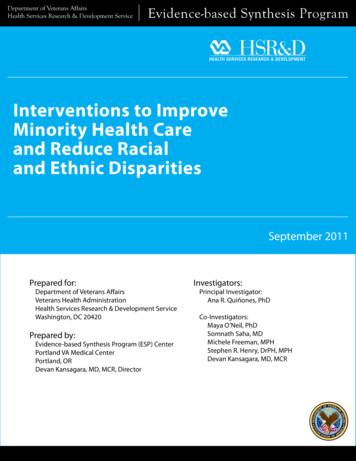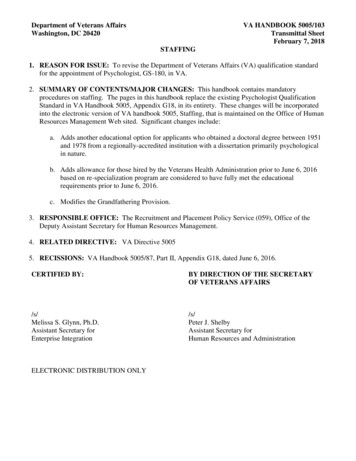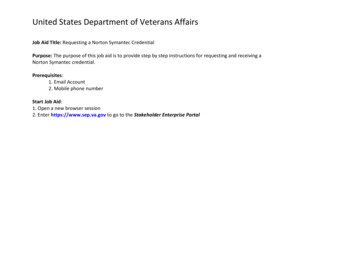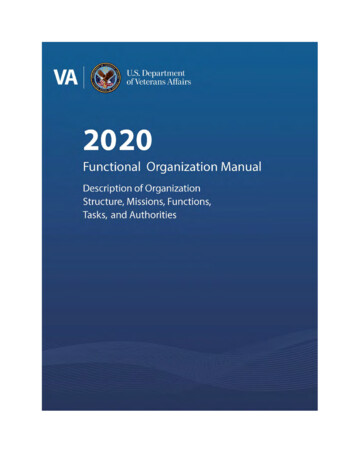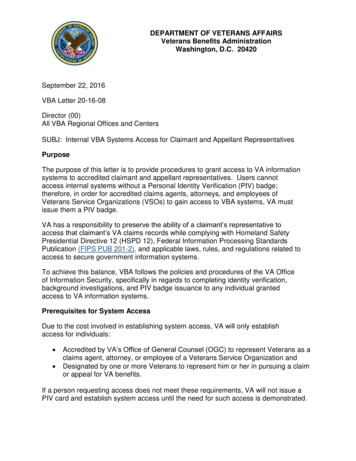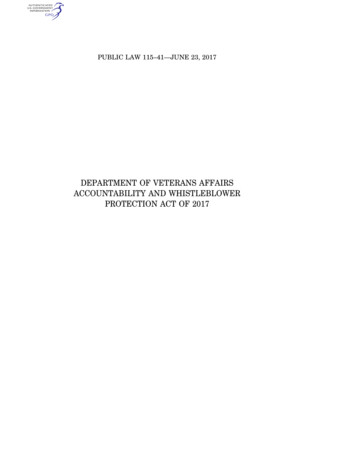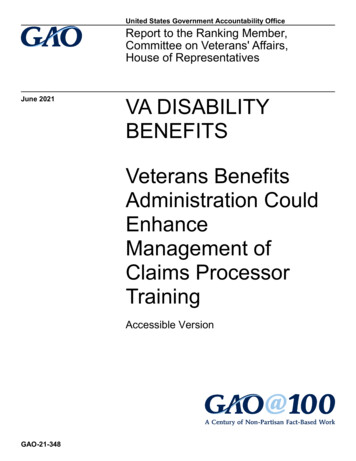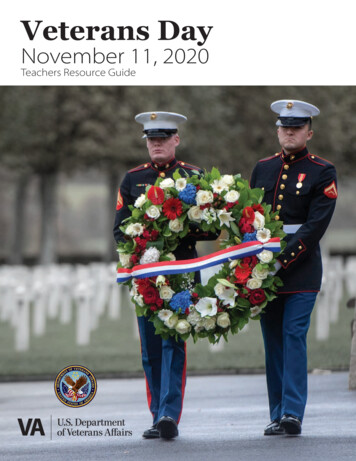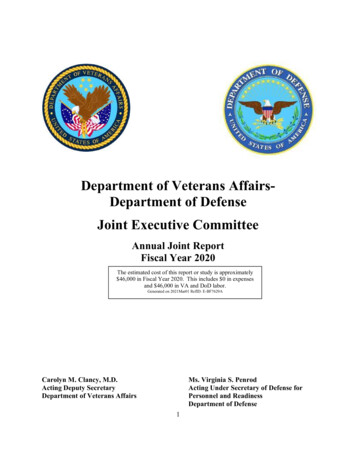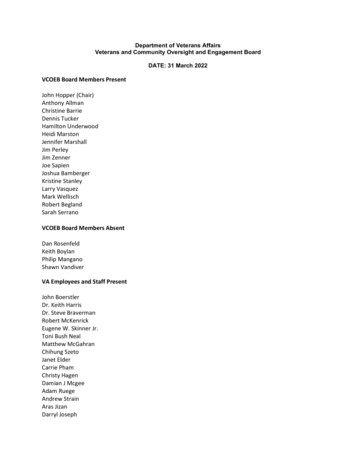
Transcription
Department of Veterans AffairsVeterans and Community Oversight and Engagement BoardDATE: 31 March 2022VCOEB Board Members PresentJohn Hopper (Chair)Anthony AllmanChristine BarrieDennis TuckerHamilton UnderwoodHeidi MarstonJennifer MarshallJim PerleyJim ZennerJoe SapienJoshua BambergerKristine StanleyLarry VasquezMark WellischRobert BeglandSarah SerranoVCOEB Board Members AbsentDan RosenfeldKeith BoylanPhilip ManganoShawn VandiverVA Employees and Staff PresentJohn BoerstlerDr. Keith HarrisDr. Steve BravermanRobert McKenrickEugene W. Skinner Jr.Toni Bush NealMatthew McGahranChihung SzetoJanet ElderCarrie PhamChristy HagenDamian J McgeeAdam RuegeAndrew StrainAras JizanDarryl Joseph
Kristin GroteclossLori MooreMarilyn BrowerRegina GriffinRoberto MarshallTeroc MezaWest Los Angeles Collective PresentStephen PeckTess BankoERPI Contractor SupportMargaret WalshCyndee Costello (Voyage Advisory)Public AttendeesJanet TurnerRob ReynoldsAnthony DeFrancescoKyle OrlemannFeras KhatibJerry OrlemannDavid LoeraLawrence LoughlinFrancisco JuarezDick SouthernQuandrea PattersonAlden BriscoePeter MullerJanelle WolvesMeeting NotesCall to Order,Attendance,Welcome,Pledge of Allegiance,Opening RemarksDFO Skinner welcomed everyone to the meeting. Mr. Szeto is the alternate DFO. The meeting was executed using the Webex eventteleconferencing platform. Federal advisory staff are available via email to assist withtechnical problems at VEOFACA@va.gov Public comments from 4:25pm – 5:15 pm Eastern or 1:24pm 2:15pm Pacific. There were 9 individuals selected in the order of eventregistration. Speakers are held to a 5-minute time limit.
Public comments can also be submitted via the emailVEOFACA@va.gov for inclusion in the official meeting record.Rules of engagement:Mute your phone lines and silence cell phones.Mute microphones on your desktop.The Chair has requested to please turn on your camera if yoursystem is equipped.Allow DFO/VCOEB Chair to yield the floor to you prior tospeaking.The Chair will ask for questions and/or comments throughoutthe meeting.Please hold all questions until the presentation is complete.Identify yourself prior to speaking.After speaking be sure to mute your microphone and turnyour cameras off.A roll call vote will be used for all proposed recommendations.Yay or nay, voice vote will be used for all proposedrecommendations.Minimize background noise while speaking.Note: this session is being recorded.Admin notes:There will not be a VCOEB GLA information exchange on April5, 2022.Planning is currently underway for an in-person meeting onJune 21-22, more information to follow as plans solidify.LTG (Ret.) Hopper welcomed committee members. VEO UpdateWelcomed Mr. Boerstler from the Veterans Experience Officeand Dr. Keith Harris the Senior Executive Homeless Agent forGLA.Dr. Harris’ first meeting where he will be a full boardparticipant in this process.Thanked Dr. Braverman and his staff for his help in putting thisparticular meeting together and for the work they do helpingour Veterans.There will be some changes in the GLA leadership and Dr.Braverman will cover those in his remarks.Mr. John Boerstler, Chief Veterans Experience Officer Looking forward to the in-person meeting in a few months. The VA Chief of Staff, Tanya Bradsher, is planning to join thein-person meeting should her schedule allow. Honored to be a part of the new updated version of themaster plan coming out soon.
VA Greater Los AngelesHealthcare System (GLAHCS) UpdateLTG (Ret.) Hopper welcomed Mr. Harris to the full board meeting. Dr. Harris was traveling at this time and informed thecommittee he would be back on camera in about 10-15minutes, Senior Executive Homelessness Agent for GLA.representing the Secretary’s Office on Veteran homelessnessin Los Angeles. Dr. Harris’ presentation was moved down the schedule and Dr.Braverman was asked to present.Dr. Braverman oThanked the board for the opportunity to participate in themeeting.oThey look forward to hosting the committee for the in-personmeeting in June provided there are no new variants of COVID.oThe last time the committee met GLA was in the beginning ofthe Omicron surge. Over 700 of the staff members got infected with 95%of them being vaccinated. None of them wereseriously ill. There was some downtime and they had to go intosome contingency and crisis staffing processes atvarious locations, that included; inpatient, medicalsurgical care, inpatient psychiatry, CLCs, domiciliaries,and the CTS program they peaked at having about 120Veterans on station that were COVID positive at onetime and more over the course of the surge. Among the Veterans that came through,unfortunately, there were 8 deaths all of them wereeither unvaccinated, partially vaccinated or immunecompromised. There is data to support the efficacy, from ahealthcare standpoint, of vaccinations. The site hasstarted offering a 4th shot - a second booster shot forthose over 50 who had been boosted more than 4months ago so they will be able to continue with theirvaccination status because it is such a life saver. During COVID and the Omicron surge the CTS anddomiciliary programs stayed open during that timedespite having some COVID infections in those areas.It was determined that the risk to those Veterans waslower than staying out on the street, especially for thecity and county of Los Angeles where almost all of theshelters were closed, and all the programs were closedbecause of COVID.
The CTS program expanded from 70 to over 100Veterans. No one got seriously ill since that’s anoutdoor program. A separate floor was established forisolation of domiciliary residents with COVID, and toour knowledge, the only county-wide Psychiatry wardfor COVID patients. So, GLA HCS was able to continueoperations during that time.The GLA HCS is in a much better place now with veryfew staff absences. There are still 4-patients in theinpatient service that have COVID, so it is not over andwon’t be over for some time. But GLA HCS is back toroutine medical operations.oExecutive Leadership team change, two in the primary carehealth care system: Dr. Marcia Lysaght last week as the Associate Directorfor Patient Care Services Nurse Executive. She will bemoving on to a promotion in the private sector to bethe Nurse Executive for Ascension Health inWisconsin. Associate Director for Resources Ms. Asher has beenpromoted to the Deputy Medical Center Director inPittsburg and will be departing April 15th. For both departures there are interim replacementswho will start. The recruitment for permanentreplacements is out on the street and closes inUSAJOBS on Friday. A third departure is Mr. Robert McKenrick who hasbeen the Deputy Director and Executive Director ofthe service and the master plan program for the lastcouple of years. He is getting a promotion to becomethe Medical Center Director, Executive Director of theVA New Mexico Healthcare System in Albuquerque,his last day will be tomorrow. Dr. Braverman wishedhim the best as he goes out to New Mexico andtackles the challenges of being a director of his ownfacility and healthcare system.oDr. Braverman highlighted some of the successes or progressthat has been made in this program since working togetherwith Mr. McKenrick over the last couple of years. Opening of the CTRS program in April 2020 when theystarted with a few tents on a parking lot which hasnow expanded to over 120 tiny shelters on the greatlawn and has been a been a very good program as alow barrier to entry opportunity for Veterans to come
Master Plan 2022 oooff the street and start getting engaged in healthcareand housing.Opening of the Uxbridge Home Shelter in conjunctionwith the partnership from the city and county of L.A.Began construction on buildings, 205, 208, 207 by theend of 2020, beginning of 2021 which will bring 180units or so to the West L.A. campus by the end of thisyear.Selection of the principle developer team, a revision ofthe Master Plan.Metro easement in the beginning of the constructionof the Metro station to be up and running by 2017.Secured funding for the utility infrastructure andparcel readiness needs that was identified in order tomove forward with construction and renovation ofmany of these buildings. Previously, there was noofficial plan.Overall, the Master Plan is back on track for many ofthe promises that the VHA has made.The staffing of Master Plan 2022 is complete, it has gonethrough VA staffing. A few changes were made based oninformation that was provided through additional consultationwith stakeholders via Dr. Harris and is waiting for theSecretary’s signature which is expected to happen in the nextfew weeks, as they’re putting together the plans for the publicroll-out of that Master Plan.There was a request to answer a few supplemental questionsprior to the formal presentation. So, Dr. Bravermansummarized them verbally and a written copy will be sent toMr. Skinner for inclusion in this meeting’s documents. Question: Can a Veteran, including homeless Veteransat CTRS and those being seen in the emergency room,receive transportation to other parts of the campuswithout a scheduled medical appointment? Response: VHA provides mileage for medicalappointments in terms of reimbursement, they willcoordinate shuttle transportation for thoseappointments. When people need shuttles outside ofthose appointments the VHA has community partnerswho run shuttles that operate on the campus andserve Veterans residing at CTRS buildings 209 andother service programs. Brentwood school provides anonsite transportation Monday through Friday, 3-timesa day starting at 9:00 AM, with stops at theEisenhower gate by the CTRS, the golf course,Welcome Center and building 402. The Disabled
American Veterans (DAV) also provides a shuttle,operated by Butterfly, that runs between the WestL.A. campus Federal Center and over to theAmbulatory Care Center. Metro, as part of our Metrocontract, operates a daily shuttle that continuouslyruns 24-hours a day, every day between the Southcampus parking lots, lots 7 by Wadsworth Chapel andbuilding 500. So, individuals from CTRS can access thatshuttle by walking less than a quarter-of-a-mile toparking lot 7. There is also a shuttle for CalVetresidents which individuals can also use as well.Question: Where does the decision that VA employeescannot hold someone for a psychiatric hold? Does thisrest with legislation or VISN administration?Dr. Bamberger interrupts to address the previousquestion regarding the transportation. This wassomething that was great concern for the ServicesSubcommittee and asked Jim Zenner if thetransportation question was sufficiently answered ordid, he have any follow-up questions to see if thetransportation needs of the Veterans on campus werebeing met. Jim Zenner had no follow-up questions butdid state that “there might be a gap there” that hewould be happy to discuss at-a-later-time.Dr. Braverman continued. The Brentwood shuttle is anew shuttle that started around Thanksgiving time. So,that is a newer opportunity for individuals and that isrunning 3-times-a-day in that particular area.Dr. Braverman reiterated the second question. Wheredoes the decision that VA employees cannot holdsomeone for a psychiatric hold does this rest withlegislation, VISN, OSP, etc.?Response: VA employees may hold someone for apsychiatric hold they must have proper training andcertification by the local government agencies locallyin West L.A., that’s L.A. County. Police officers don nothave that authority per the VA’s Office of GeneralCounsel, and the VISN 22 senior security officer has ateam working on some other procedure there. Thereare currently psychologists and psychiatrists on staffwho are trained and authorized to place patients onpsychiatric holds.Question: Are there any local concerns at the medicalcenter level around VAPD having hold authority or LPSdesignation?Response: Generally, they do not have any concerns,but there is a plan for increased access and some
oimprovement with the process. For those who are notfamiliar with LPS it refers to Lanterman–Petris–Short(LPS) Act of 1967 which establishes the legal basis fordetaining and treating psychiatric patients. And that isadministered here on the county level where theyreside. The inpatient facility is also designated as anLPS facility so that means they can receive and treatpatients with the various forms of involuntarydetention. Two major ones: A 5150 which is a short-term 72-hour hold, and 5250 which is a two-week hold.And then after that, it gets into conservatorshipthrough the courts and that is based on whethersomebody is a danger to self or others, or gravedisability as defined as being unable to provide forthemselves. Psychologists and psychiatrists currentlyhave that availability within the VA GLA privilegingservices here once they take the county courseworkand pass the exam right now when VAPD is called toan address a situation involving such an individual theymake contact with one of VA GLA’s privilegedclinicians who are on call, in order to place a hold. Iffor some reason no one is available, they may also callthe Mental Evaluation Team with LAPD to assist. Theyhave approval and funding to stand up their ownVeteran Mental Evaluation Team, as previouslydiscussed, then, social workers who will be part of theprogram will also receive the training. Once they passthe exam, they will be able to apply those 5150 holdsin association with our police department with theVMET. Currently, one police officer serving in thatVMET capacity, a part-time social worker as atemporary detail while recruiting for two socialworkers to join that team on a permanent basis. Thatwill enhance capability, but they are able to do thoseas needed now.Dr. Bamberger expressed the concern of the ServicesCommittee that if a Veteran was at risk for coming tosignificant harm, either to themselves or others, because oftheir severe mental illness. If the system that is presently inplace would be responsive enough to be able to keep themsafe, or if there would be a gap between identifying someonein a serious situation and then having to go through thisderivative of calling somebody. It sounds like Dr. Bravermanhas recognized that gap and is working towards resolving thatwith the VMETs. He then asked:
“Are you content where things are at this stage, or, doyou feel like you’re still working to find a gap thatneeds to be filled?”Dr. Braverman responded. Probably less of a gap than atimeliness issue. Having social workers as part of the VMETswill be important and improve the timeliness. He was notaware of any situations where they did not have availability ofclinicians that resulted in any kind of negative outcomebecause of a short delay in order to contact somebody. Thereare individuals brought into the emergency departments on5150s frequently and he has not seen a big gap. He didacknowledge that there is always a little risk that they canmitigate by putting this VMET program into place and that isthe goal.Mr. Zenner asked Dr. Braverman if there was a hesitancy toexpand it to social workers beyond the VMET team becausethere is probably a lot more availability of the social workersthan there are of psychiatrists and psychologists.Dr. Braverman informed Mr. Zenner that he would not call it ahesitancy, they had not identified that as a need prior to this.It is not currently in the social work scope of care but that issomething that they are looking at as they prepare for theVMETS, as well as if they need to have other trainedindividuals in order to expand the capability they will certainlylook at that.Dr. Bamberger thanked Dr. Braverman for answering thequestions out of cycle.Dr. Braverman turned it over to Mr. McKenrick for the nextpresentation.LTG (Ret) Hopper thanked Dr. Braverman and asked if he knowwho the interim replacement for Mr. Kenrick might be.Dr. Braverman provided the information that he was aware of: Because Mr. McKenrick is an SES they must go throughCMO and OPM protocols. So, Dr. Braverman candesignate somebody for up to 30 days as an interim. Alan Trinh will be serving in that capacity for the firstmonth or so of April. Sometime either tomorrow or next week they expecta recruitment, both for an interim as well as apermanent replacement, to go out through CMO tofind someone for a longer period of time.LTG (Ret) Hopper thanked Dr. Braverman again.Dr. Bamberger asked if they had considered putting a personwith a homeless expertise component in the jobannouncement as they recruit the position. He was wonderingif this was on their radar and an expectation of it.Dr. Braverman responded. Yes, that is part of the jobdescription as well as for strategic planning. oooooooooo
oooooooLTG (Ret) Hopper checked to see if Mr. McKenrick was on theline. Then asked if Dr. Harris was ready to make somecomments.Dr. Harris thought much of his content would be coveredbetween Dr. Braverman, Mr. McKenrick and Mr. McGahran.What he wanted to share with the group was that he has beenin his new position for a little over 3 months, and deeplyappreciative to the VCOEB and the many board members thathe has met with on both subcommittees. He came withsubstantial experience on the homeless services side muchless so on the Master Plan campus development side. Heappreciated the expertise of this board. He has met withdozens of different groups, and agencies and just recentlymeeting with key VSOs who have been involved with the workhere on all aspects of it for many years. Their perspectiveshave been valuable Dr. Braverman referenced that he wasable to take some of the feedback he received and workedwith the team at GLA to incorporate that into the final versionof the Master Plan. He wanted to share on the services side ofthings. They have technical assistance providers here ongrounds this week, reviewing a series ofrecommendations on how to improve homelessservices for Veterans across the board and it touchesnearly every aspect within the continuum Outreach and identification of homelessVeterans through the process of referringVeterans to the programs at VA GLA, Moving Veterans rapidly through intopermanent housing.All of this in support of the goals that the Secretary recentlyannounced with the central one being the goal to house 1,500Veterans into permanent housing during this calendar year.They will be able to share the services improvement workunderway right now with the group in the coming months.Dr. Harris then asked if there were any questions from theboard specifically for him.LTG (Ret) Hopper asked the group if there were any questionsfor Dr. Harris.LTG (Ret) Hopper thanked Dr. Harris and welcomed himaboard. Then turned it over to Mr. McKenrick.Mr. McKenrick presented the Master Plan agenda; the itemswere based on the questions they had received. The intent isto answer the questions and have dialogue where appropriate.1. Master Plan 2022 Approval Status
Background: Master Plan 2022 was finalized – beginning theconcurrence process on January 7th, 2022. Package cleared concurrence process with hardcopydelivered March 21st, 2022. Pending SECVA signature.Concurrence Process:VAGLAHS to VISN to VHA to VACO to SECVADr. Harris mentioned that he was able to provide some feedback andthey were able to “tweak” a few things in the master plan thatremained concerns for some of the VSO entities that Dr. Harris hadmet with. So, it is at the Secretary’s level, at this point they arereviewing the “Forward” and finalizing any other edits, but theybelieve they have the final for signature and will be working on thatover the next few weeks.Mr. McKenrick continued the discussion.2. FY22 Budget – Does the budget fully support theMaster Plan 2022?VA GLAHS has an approximately 1 billion operating budgetthat supports: Approximately 5,600 employees, 87,000 enrollees, Large 1A integrated HCS over 20,000 sq. miles,Across 5 counties the majority of LA county. Long Beach ducksinto the southeastern corner of LA county, Ventura, and upinto Santa Barbara. The Santa Maria area, San Luis Obispo andacross Kern county, Bakersfield and Lancaster. Eleven sites of care; 1 x VAMC, 2 x ACCs, 8 x CBOCs, WLA VAMC sits on 388 acres, Sepulveda AmbulatoryCare Center sits on 144 acres. A very large area, over200,000 Veterans, 604 operating beds, Large affiliated academic programs about 2000students per year, Extensive research program.When talking about the budget the first differentiation is: The Master Plan and the efforts here to build 1200permanent supportive housing units and all thoseadditional activities that go into a Veteran community, the building of the Master Plan on the North campus, the turnover projects for the parcels,
upgrading of the utilities.These are a different budget, there are some slides that will showthese projects and budgets, but they are not part of the 1 billionhealth care budget that is dedicated for the health care system.The health care system budget also serves the mission for thehomeless as well as personnel and their efforts these are appropriatedfunds. They are working on moving the Care Treatment andRehabilitative Service (CTRS) from an initiative to a validated programthat can then use appropriated funds. So, a little bit of crossover in thebudget, but the service budget is adequate for the mission they aredoing. They are changing around some of the ways that service doestheir mission and adding additional emphasis, some additionalpositions, and adjusting the positions in some areas that will allowthem to ramp up their activities. He wanted to put this up first as ananswer to the question #2, the overall budget.3. What are the shortfalls? What are the impacts? Whatis the VA doing to mitigate?Master Plan 2022 is outside the VA GLAHS operating budget.To understand the budget impact of Master Plan 2022 andmitigate the risk of shortfalls, VA is: Collaborating across the agency and with senior VAleadership to phase the turnover of parcels to the EULprogram in alignment with developer financingstrategies, advance the development of VA majorhealthcare facility projects, and integrate communityamenities. Contracting engineers to develop projects to upgradeinfrastructure for the turnover of parcels to the EULprogram. Working with VISN, OAEM, HEFP, VHA, and senior VAleadership through VA’s Strategic Capital InvestmentProcess (SCIP) to allocate funding arrangementsspecific to these Master Plan activities that fall outsideof the healthcare operating budget.Funding Request Process:VAGLAHS Integrated Project Team (IPT) to VISN to HEFP to VHAThe Chief of Staff has taken the leadership role as the executivesponsor. There are monthly budget updates, detailed review ofmaterial as well as other supporting aspects, goals and efforts with theIPT members. Meetings with Mr. Brett Sims from the Office of AssetEnterprise Management, legal counsel, VHA leadership and otherentities around the IPT to tackle challenges such as budgeting costs,
things that need to happen for sequencing, so there are no surprises. Ifthere are issues identified there is an integrated team to resolve thoseissues outside of the normal GLA budget process.The IPT underlies the integration of staff and efforts on theseprojects, Construction and facilities management officer theirengineers and several of their people are integrated, A few people from OAEM and others visiting thisweek.VA’s Strategic Capital Investment Process (SCIP) program is the waythe VA focuses across the nation to prepare for the Secretary fundingrequests by specific projects that are approved and that they want togo to Congress and Office of Management and Budget (OMB) to showwhat they are budgeting in the out years for these projects.The types of projects that are included: Major construction, like the new bed tower, Some minor constructions such as: Rehab of particular buildings, interior orexterior, or a smaller project. These wouldneed to get into the SCIP process. Non-Reoccurring Maintenance (NRM) projects, someof the upgrade activity on the north campus fall underthe NRM efforts. These would need to get into theSCIP process.They have already worked with the VISN, the regional CFM andthrough OAEM to identify some fast track potential and a differentarea that they can move some of these projects to, because when theyget into a building or the building’s called for, or like parking lots 38and 48, they were moved forward on the schedule by a year or more.They had to move quickly, and they were not able to go through thetwo or three-year SCIP planning process. So, there isacknowledgement that the work they are doing is unique and theyneed to move the project faster. They have the support of the VISN todevelop a contracting team to develop the project contracts in supportof the engineering team to ensure that they move through timely, getto solicitation, bidding and award to get under construction quickly tomeet their timelines for the housing. They are starting to realign andadvertise for individuals to work on the project contracts team.Currently, there has been no delays because of this process but theyare refining how they do this to make sure that the system can handlethe capacity that will be needed.
oLTG (Ret) Hopper comment/question: the project itself is amandate from the result of a lawsuit to redevelop this landinto a soldier’s home is outside the VA GLA’s normal healthbudgeting process. Going into Fiscal Year 2022 did you have abudget? Was it funded? And is it going to meet therequirements of Master Plan 2022?oMr. McKenrick responded. The turnover activities were notwhat had been anticipated. The Office of Asset and EnterpriseManagement (OAEM) started using some capital funds to startassessing properties to determine what remediation ormitigation activity needed to be done. They were aware thatthere was some asbestos mitigation that needed to be done insome of the buildings, so a budget was developed for thatyear. The engineering team was brought on and during 2021they started flushing out all the other projects in those areaswhether it was moving a steam line underground, moving apower line around on a parcel, these were the things thatwent into that budget. They worked through 2021 with thefirst budget for the actual turnover activities, and with nearly30 parcels to be turned over they started assessing whatparcels were next on the list to be turned over, and theywould need to get the engineers out there to determine whatactivities would have to be done on each of those parcels forturnover. It was known that an upgrade of the utilities wouldbe needed, there was the short-and-long term water projects,so they were added to the list. So, they asked for and receivedall the funding for the first year, no shortfall there. Then, theydid not go through the normal SCIP process, but theydeveloped a request via memo through the VISN, VHA, and upto VA Central Offices, CFM and OAEM were partners on that,and they made a request for 2022 funds, and all of that hasbeen funded.The budgets for 2021, 2022 have been fully funded, they havea rough budget for 2023. The parking lots came forward in2022 so they had to adjust the budget a little because theyhave building 233 on one of the parking lots. Building 233 is asmaller block house building that packages their medicalwaste that is then sent off-site per contract for appropriatedisposal. Since they were unaware that the parking lots werecoming, they did not know building 233 had to be remediated.So, the budgets change as they got more refinement, but toanswer the question, they have a 2021, 2022 budget and arough draft of a 2023 budget that they continue to flesh out.
Mr. McKenrick then asked if that answered the question.oLTG (Ret) Hopper responded: “Partially it does, are there anyother VA programs that looks like this soldier’s home?”oMr. McKenrick’s reply: Not that he was aware of given theactivity that they are doing to develop this. There are othermedical centers, Dr. Braverman can speak of the medicalcenter he was at where they had a couple of EUL buildings,there are 2 EUL buildings at Sepulveda but they are verycontained and limited. They did not require an upgrade of theutilities across a good portion of a large campus nor did theyrequire this huge turnover activity of land use to clear the landof all uncovered utilities and other things such as theremediation of some hazardous materials like asbestos. So, hewas not aware of any other facility across the nation that hasthe scope or the depth of what they are trying to do here inthe Master Plan.oLTG (Ret) Hopper question: “Do you feel like the budgetingfunding process is now caught up with the scope of theprogram?”oMr. McKenrick’s reply: He believes it has and, surprisingly, allthe money that has been asked for has been received throughthe process, whether it came through OAEM as capitalinvestment, or VHA and higher, or through the VISN they haveexplained why it was needed, how they arrived at the point ofthat need. Each time funding has been asked for it has beenapproved so there have not been any funding challenges.oLTG (Ret) Hopper thanked Mr. McKenrick for his response.oDr. Bamberger comment/question: “It seems we are trying todo a lot with healthcare dollars and turn the healthcare dollarsto gold somehow, housing and so forth. As you leave thisposition do you have any suggestions as to how this could bebetter from your perspective? Now that you’ve done this for awhile and struggled with trying to turn healthcare dollars intohousing and other things that have been required and all thesecomplicated partnerships. Any suggestions?”oMr. McKenrick’s reply: He agreed that it is outside of thenormal healthcare process/system to do a community. He cansee where it is reasonable, and it is an effective process. TheOffice of Asset and Enterprise Management (OAEM) ca
health care system: Dr. Marcia Lysaght last week as the Associate Director for Patient Care Services Nurse Executive. She will be moving on to a promotion in the private sector to be the Nurse Executive for Ascension Health in Wisconsin. Associate Director for Resources Ms. Asher has been promoted to the Deputy Medical Center Director in
